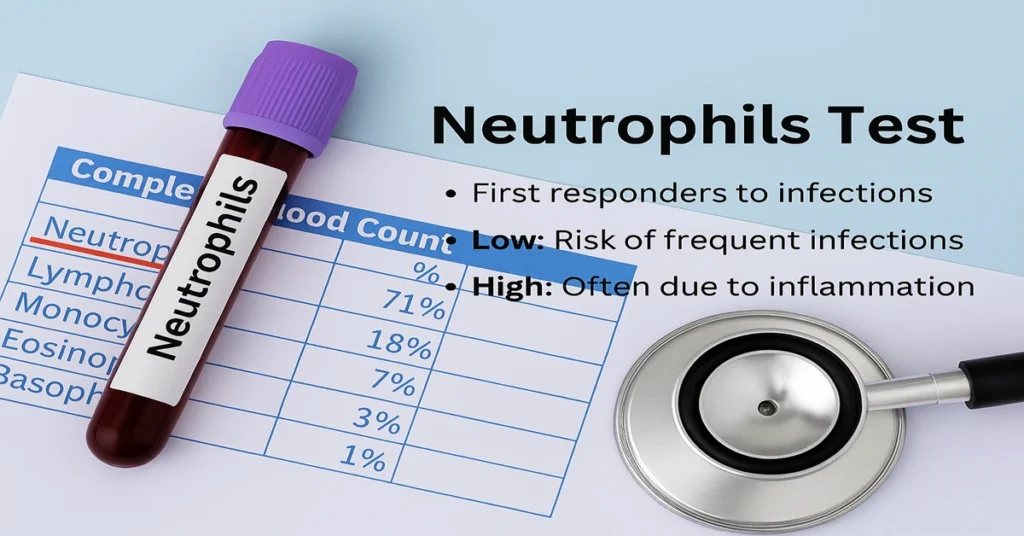What is the Neutrophils Test?
The Neutrophils Test measures the number or percentage of neutrophils in your blood. Neutrophils are a type of white blood cell (WBC) and are the first line of defense against infections, especially bacterial infections.
This test is usually part of the Complete Blood Count with Differential (CBC with diff), which shows the breakdown of all types of white blood cells.
Where Are Neutrophils Synthesized/Produced in the Body?
Neutrophils are produced in the bone marrow from stem cells. After maturing, they are released into the bloodstream where they act immediately if an infection occurs. They are part of the body’s innate immune system, meaning they respond quickly and automatically without prior exposure.
Main Functions and Importance of Neutrophils
- Destroy Bacteria and Fungi: Neutrophils quickly attack germs.
- Phagocytosis: They “eat” and digest harmful microorganisms and dead cells.
- Inflammation Response: Release chemicals to promote inflammation and healing.
- Short but Powerful Lifespan: Act fast and die after fighting infection, often forming pus.
Without enough neutrophils, even a small infection can become dangerous.
Causes of Low Neutrophil Count (Neutropenia)
- Severe infections (bone marrow exhaustion)
- Bone marrow disorders: leukemia, aplastic anemia
- Chemotherapy or radiation therapy
- Autoimmune diseases: lupus, rheumatoid arthritis
- Vitamin B12 or folate deficiency
- Genetic disorders: congenital neutropenia
- Medications: certain antibiotics, antipsychotics
Symptoms of Low Neutrophils (Neutropenia)
- Frequent infections
- Fever and chills
- Mouth ulcers or sore throat
- Slow wound healing
- Fatigue
- Severe neutropenia → infections may appear suddenly and become life-threatening
Causes of High Neutrophil Count (Neutrophilia)
- Bacterial infections (pneumonia, urinary tract infection)
- Inflammatory conditions: rheumatoid arthritis, IBD
- Physical or emotional stress
- Smoking or heavy exercise
- Injury, burns, or after surgery
- Certain cancers: leukemia
- Medications: steroids, lithium
Symptoms of High Neutrophils
- Often no direct symptoms
- Underlying infection signs: fever, body pain, swelling, redness
- CBC report shows high WBC with elevated neutrophils
Reference Ranges
(may vary slightly by lab)
- Absolute Neutrophil Count (ANC):
- Normal: 1,500 – 8,000 cells/µL
- Mild Neutropenia: 1,000 – 1,500
- Moderate Neutropenia: 500 – 1,000
- Severe Neutropenia: < 500 (dangerous)
- Neutrophil Percentage (in WBC differential):
- Adults: 40% – 70% of total WBCs
- Children: 30% – 60%
Sample Type
- Sample: Whole blood
- Tube Used: Lavender-top (EDTA) tube
Test Preparation
- No fasting is required.
- Inform your doctor if you are on chemotherapy, steroids, or medications affecting immunity.
- Avoid heavy exercise just before the test (may raise neutrophil count temporarily).
When to Consult a Doctor
- If you get frequent or unusual infections.
- If your CBC shows neutrophils consistently high or low.
- If you experience unexplained fever, mouth ulcers, or slow healing wounds.
- If you are undergoing cancer treatment or have autoimmune conditions.
Key Terms Explained
- Neutrophils: A type of white blood cell that fights bacteria and fungi.
- Neutropenia: Low neutrophil count → higher infection risk.
- Neutrophilia: High neutrophil count → usually due to infection, stress, or inflammation.
- ANC (Absolute Neutrophil Count): Exact number of neutrophils per microliter of blood.
- CBC with Differential: Blood test that breaks down all types of WBCs.
~END~

